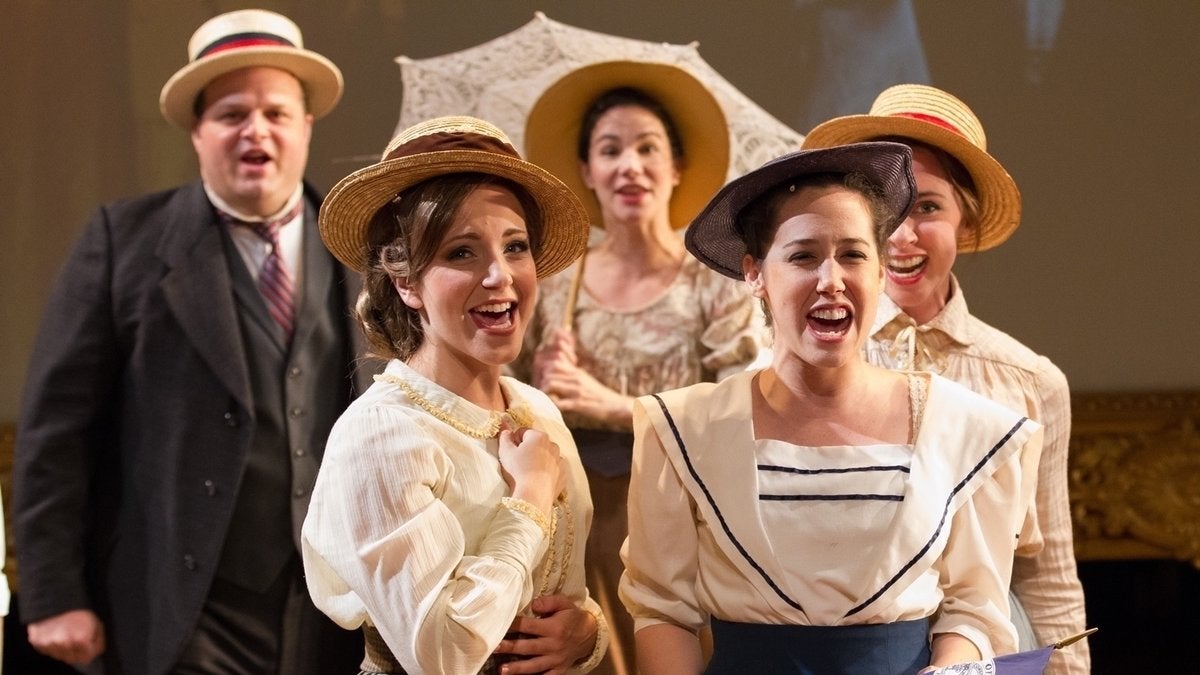Review: ‘Parade’ passes by, then and now and all at once
Listen
From the left, Scott Greer, Rachel Camp, Sarah Gliko, Alex Keiper and Caroline Dooner of the ensemble in Arden Theatre Company's production of Parade. Photo courtesy of Mark Garvin.
The Arden Theatre Company’s stage bursts with talent in its meticulously delivered production of “Parade,” but the person most responsible for the 19th-century look and magnetizing feel of the show is nowhere to be found.
As usual for the locally-based scenic and video designer Jorge Cousineau, his work on stage speaks for him. In less than two decades, computer-age visual effects have arrived with a pioneering sense of urgency on theater’s stages – particularly for musicals. Cousineau leads one of the mule teams out there, taming the wilds.
A few seasons back, he and Arden producing artistic director Terrence J. Nolen teamed up to conceive a context for Stephen Sondheim’s “Sunday in the Park with George,” and the result was every bit as remarkable as another high-tech conception on Broadway. Now Cousineau and Nolen work magic on “Parade,” the musical taken from an actual mockery of justice in the Old South 100 years ago.
The entire production is set in front of a large screen in a hugely oversized gilded frame. The images Cousineau manipulates to put on that screen take us solidly into the late early 20th century and into the plot of “Parade,” along with the costumes on the live actors by Rosemarie E. McKelvey. The screen has sepia-toned and newsreel-scratched filmed scenes of the cast rallying as they also perform, live, in front of us. It has trolley tracks captured by a camera moving through a century-old downtown; two live characters sing on a trolley bench that seems to be moving but isn’t.
Cousineau’s screen shows live shots of characters reacting to what’s happening on stage – and they, too, appear to be filmed back when movies were new. In one scene, a character performs an entire number on screen; in another, a perfectly timed conversation goes on between a filmed character and a live one. All the time, the on-screen images blend with the live action on stage. For someone watching, it’s a sort of intellectual 3-D, a trick our brain plays by seeing the present and the past at once, but suspending us in a moment neither here nor there.
“Parade” is by Alfred Uhry, who’s also given us “Driving Miss Daisy,” another slice of Southern life. The score, tuneful but not something you’d hum, is by Jason Robert Brown, who composed the popular song cycle “The Last Five Years.” “Parade” is not a musical you like, it’s a musical you admire, which is something very different. And in the Arden’s version, you admire it all the more for a theatricality that never lags.
“Parade” dramatizes a horrible incident in and around Atlanta, where a young Jewish man from Brooklyn named Leo Frank was supervising production at a company that manufactured pencils in 1913. Frank is portrayed in “Parade” as a haughty, stiff square peg trying with increasing frustration to fit into the magnolia-spiked round hole of Georgia.
A young woman who worked for him was found dead in the pencil factory, and Frank, not naturally likeable, was almost instantly accused with nary a bit of evidence. Then he was demonized by the Jew-hating locals, whose public officials found ways to coerce Frank’s workers into fabricating terrible tales about him on the witness stand: He was a letch, he was a deceiver, and by his trial’s end he was little more than a wild animal in portraits painted by the liars (and by at least one big newspaper still around today).
In its depiction of a community overtaken by suspicion based on lies, “Parade” is very much like a celebrated drama, Arthur Miller’s witch-hunt masterpiece “The Crucible.” But in its no-punches regard for Southern injustice, “Parade” has a cousin in a more recent musical, “The Scottsboro Boys” – and in fact, both “Scottsboro” and “Parade” have similar Broadway records. They didn’t last. “Parade,” directed by Harold Prince, ran a scant 128 performances. Americans seem unable to support Broadway musicals that illuminate the dark sides of our national psyches, but accept dramas that do.
So we’re fortunate to have regional theaters that run on art as much as on money — and not overwhelmingly on money, the Broadway model. “Parade” is nothing if not artful; its scenes are tightly pieced together, its tale spins equally through its words and songs. These are performed, under Nolen’s direction, by a cast that includes many professional Philly veterans, all of them at the top of their games: Ben Dibble is Leo Frank and Jennie Eisenhower, his strong-willed and crafty wife. Jeffrey Coon plays a reporter on the murder scoop, plus several other roles; Scott Greer also juggles roles, and is most notably Georgia’s governor. Anthony Lawton is the perfectly hateful prosecutor, and Michael Philip O’Brien plays a number of townsfolk.
Dennis Holland plays the judge, Derrick Cobey and Kenita R. Miller are servants or factory workers (they perform a great duet that underscores the complexity of Southern hate at the time). Kathryn Brunner is the murder victim and Sarah Gliko, her mother. This leaves several supporting players – among them Robert Hager, who plays one of the trial’s most ardent fabricators and when he’s singing angrily, looks a great deal like a very young Edward G. Robinson.
I tip my hat to them all, for the way they bring alive this severe, shameful time. Both in person and on film.
“Parade” runs through November 3 at Arden Theatre Company, on Second Street north of Market. 215-922-1122 or www.ardentheatre.org.
WHYY is your source for fact-based, in-depth journalism and information. As a nonprofit organization, we rely on financial support from readers like you. Please give today.




